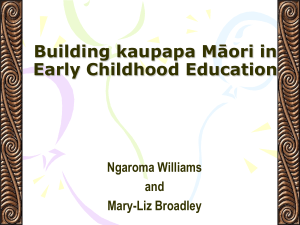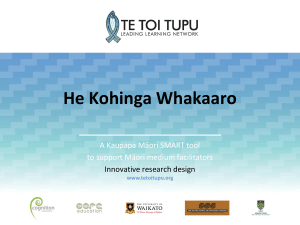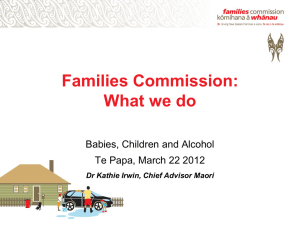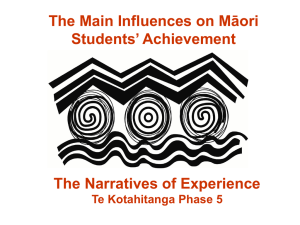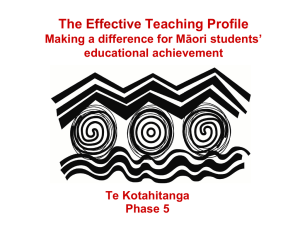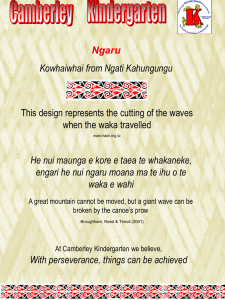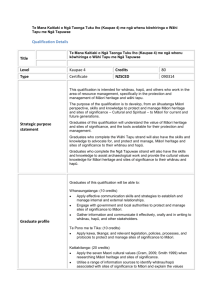Cultural Enhancement Framework
advertisement
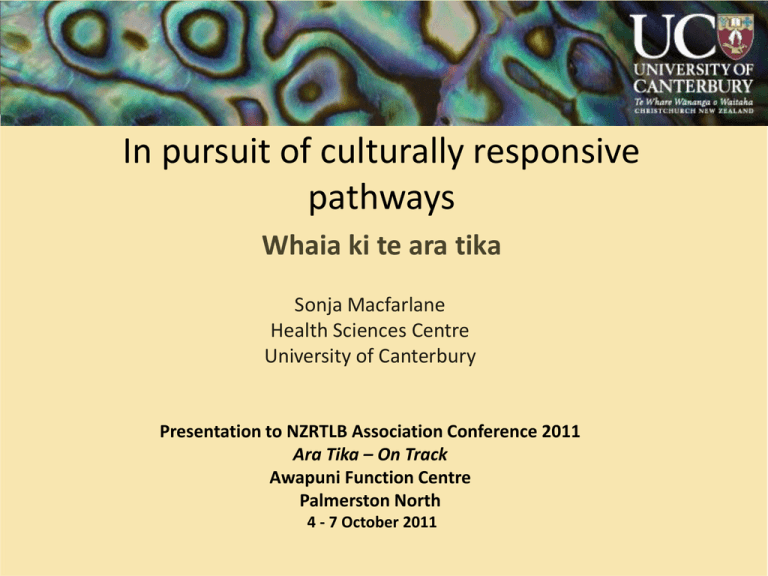
In pursuit of culturally responsive pathways Whaia ki te ara tika Sonja Macfarlane Health Sciences Centre University of Canterbury Presentation to NZRTLB Association Conference 2011 Ara Tika – On Track Awapuni Function Centre Palmerston North 4 - 7 October 2011 Ko wai ahau? Ko Aoraki te maunga Ko Takitimu te waka Ko Arahura te awa Ko Arahura te marae Ko Ngāi Tahu te iwi Ko Ngāti Waewae te hapū Ko Sonja Herahine Macfarlane toku ingoa No Arahura ahau Ōku whaea Merehererika Pikaka (Merika) Herahine Meihana Rosalyn Morehu Paaka Merkia Bergman Tōku Taua, me tōku Hākui The aims of this presentation » To consider the paradoxes that exist in the relationship between policy and practice » To explore the dimensions of culturally responsive practice » To reflect on perspectives about ‘evidence’ » To propose that there are five key influences of cultural provision » To introduce four examples of biculturally responsive frameworks Increasing professional learning and capability… “Reflection is pivotal to professional development, where the re-thinking of experience provides added personal meaning and learning” (Hoban, 2002) ….and reflecting on the following: •“How do you know that what you do and how you do it really works?” AND •“What, among the many things that could be done for a child or young person, ought to be done?” • (Holm, 2000) Te Pūtake o Aoraki: Base-lining Potential A kaupapa Māori reflective process Hokingā Maumahara: Drawing from the past … Enlightening the future 1. Look to and reach into the past 3. Project towards the future Ki mua The past Ki muri The future 2. Draw from the 4. Practice and knowledge reflect Pathways to the future: Ngā ara ki muri Having a vision: • What pathways do we want to forge? • Why do we want to forge them? • How will we forge them? • What evidence will inform the way this is done? • Who will validate this? Having a vision: The overarching strategic intent (vision) of Ka Hikitia is: “Māori students enjoying education success - as Māori” Mason’s 3 goals To live as Māori To actively participate as citizens of the world To enjoy good health and a high standard of living Focus Area 4: Ka Hikitia Organisational Success Organisational Success concentrates on improving the Ministry of Education’s ability to focus its work in policy and implementation on what evidence tells us will improve education outcomes for Māori. » using and acting on evidence about what works for and with Māori students Policy, practice, and evidence Consider the following: » What informs policy? (Knowledge, worldview perspectives, evidence....) » What informs practice? (Knowledge, worldview perspectives, evidence....) » What constitutes evidence? Policy, practice, and evidence One pathway Problem is identified to initiate Research Data collection is reviewed to develop Policy is implemented to guide Practice is reshaped to respond to the problem Practice Policy, practice, and evidence another pathway Problem is addressed by implementing tikanga (practice) Practice Tikanga is implemented to guide Policy Planning; Kaupapa is developed to highlight Research Data collection is reviewed to identify Problem Pathways to understanding: pathways to culturally responsive practice “There are ethnically-linked ways of thinking, feeling and acting, that are acquired through socialisation” (Phinney & Rotheram, 1987) Culture is.... “Culture is a convenient way of describing the ways members of a group understand each other and communicate that understanding” (Durie, July 2003; pg 2.) Cultural competency is.... “Cultural competence is the acquisition of skills so that we are better able to understand members of other cultures in order to achieve best outcomes….it is about being able to understand the people who we are going to deal with, as practitioners…” (Durie, July 2003; pg 2.) Cultural competency Where do we locate ourselves? and How might we move along the continuum? The Cultural Competency Continuum 1 Cultural Destructiveness 2 Cultural Incapacity 3 Cultural Blindness 4 Cultural Precompetence 5 Cultural Competence 6 Cultural Proficiency The Cultural Competency Continuum 1 Cultural Destructiveness 2 Cultural Incapacity 3 Cultural Blindness 4 Cultural Precompetence 5 Cultural Competence 6 Cultural Proficiency This challenge involves moving as far as possible, as quickly as possible, along the following six-point continuum (Cross et al., 1989): Cultural destructiveness: those who believe or engage in behaviours that reinforce the superiority of one race or culture over another, with the resultant oppression of the group viewed as inferior; Cultural incapacity: those who have less actively destructive beliefs or behaviours, but are paternalistic and lack the skills to be effective with individuals from diverse groups; Cultural blindness: those who profess that culture, race and / or language make no difference and explicitly or implicitly encourage assimilation; Cultural pre-competence: those who accept the need for culturally competent policies and procedures, but do not proceed beyond tokenism or searching for ways to respond; Cultural competence: those who accept and respect differences and implement policies that support these beliefs and commitments; Cultural proficiency: those who seek to refine their approach by learning more about diverse groups through research, dissemination and fully inclusive practices. Culturally competent practice about the relationship between the ‘helped’ and the ‘helper’ practitioner based about accepting and respecting differences about implementing policies and practices that support these beliefs and practices about capacity and capability driven by the practitioner Culturally safe practice about the relationship between the ‘helped’ and the ‘helper’ about experiences that emerge from relationships client based client safety ‘do no harm’ determined by the client Culturally responsive practice √ Doing the right things – tika; Doing things right - pono Understanding the significance of cultural iconography and practices Relating to people in ways that promote respect for cultural diversity Doing the most appropriate thing by the other culture in terms of our understandings and experiences of their culture Determining what is appropriate for the context or situation given the cultural backgrounds and perspectives of those involved Providing opportunities for both parties to listen and learn from each other without imposing one’s own cultural views on to the other Having an awareness and acting appropriately Inviting and enabling others to bring their own cultural understandings and experiences to the relationship and interactions Culturally Responsive practice.... Cultural safety: tamaiti and whānau Cultural competency: practitioner CULTURALLY RESPONSIVE provision Research Practitioner skills & knowledge Whānau wisdom & values ‘Back-to-the-future’ best evidence and practice Traditional Māori New -Poi / mau taiaha -Kapahaka -Hand games, string games -Brain gym -Sensory-motor -Kinaesthetic / tactile -Whānau, hapū, iwi -Marae -Inclusion -Ecological -Karakia -Pepeha / whakapapa -Waiata -Pūrākau -Rote learning -Whakawhanaungatanga – a fundamental underpinning value -The importance of relationships for effective teaching -Ako -Tuakana / teina -Cooperative learning -Peer tutoring -Hui whakatika -Traditional Māori discipline (noa) -Restorative justice -Marae-based learning -Modelling He ritenga whaimōhio: Culturally grounded and informed evidence based practice He ritenga whaimōhio: Evidence based practice TIKA RESEARCH Literature that is culturally grounded, relevant, authentic and realistic AROHA WHĀNAU Interactions and consultations with the whānau that are interactive, respectful and compassionate PONO PRACTITIONER KNOWLEDGE & SKILL Actions that have integrity, are reasoned, just and fair Five influences of cultural provision 1. 2. 3. 4. 5. Content integration Knowledge construction Equity practices Skilled providers Empowering organisational culture Empowering Organisational culture 1. Content Integration 2. Skilled Providers Empowering Organisational culture Introducing four pathways to bicultural practice Pathway 1 1.Waharoa Whāinga Cultural Enhancement Framework » Purpose / Whāinga: Aims and Objectives » Benefits must ensue for Māori who participate in this programme What is the purpose of this programme? Why is it important that we deliver this programme to Māori? How is it intended that this programme will benefit Māori? Have senior Māori (pakeke, kaumātua) been involved / consulted at the enhancement, planning, and preparation stage? How? » Does the programme preparation, planning, and delivery have endorsement from senior Māori to proceed? » » » » 2. Kitea Te Kanohi Tekoteko 1. Whāinga Cultural Enhancement Framework » Kānohi kitea: The seen face » This component will be demonstrated by ensuring that culturally-competent and experienced Māori will be facilitating / co-facilitating the delivery and implementation of programmes to Māori, so that they are able to respond to Māori cultural concerns and considerations personally. 3. Karakia Koruru 1. Whāinga 2. Kanohi Kitea Cultural Enhancement Framework » Karakia: Transition » Space will be available for karakia / incantation / prayer to be used where appropriate, in order to create a safe environment within which to work. 3. Karakia 4. Ngā tikanga me ngā kawa Amo 1. Whāinga 2. Kanohi Kitea Cultural Enhancement Framework » Ngā tikanga me ngā kawa: Maintaining protocols and traditions » Space will be created for the inclusion of senior Māori (pakeke, kaumātua) as guardians of cultural quality and fidelity, and to uphold the mana of the programme and participants. 3. Karakia 4. Ngā tikanga me ngā kawa 2. Kanohi Kitea Amo 5. Te Reo 1. Whāinga Cultural Enhancement Framework » Te reo: Appropriate use of language and effective communication » Effective communication will be demonstrated by ensuring that materials, methods and modes are culturally congruent; appropriate and responsive to Māori. Space will be allowed for te reo Māori and non te reo Māori speakers to express themselves in their language of preference outside of the formal and ritual contexts. 3. Karakia 4. Ngā tikanga me ngā kawa 2. Kanohi Kitea 5. Te Reo 6. Raparapa Powhiri 6. Poroporokai Raparapa 1. Whāinga Cultural Enhancement Framework » Pōwhiri and poroporoaki: Transactional engagement: the initiation of engagement » Space will be created for tikanga Māori to be embedded and demonstrated in the programme where pōwhiri (welcome) and poroporoaki (farewell) processes are an integral part of the interaction / relationship. 3. Karakia 4. Ngā tikanga me ngā kawa 2. Kanohi Kitea 5. Te Reo 6. Powhiri 6. Poroporokai 7. Mihimihi 1. Whāinga Cultural Enhancement Framework » Mihimihi: Establishing connectedness; establishing relationships » Space / time will be available for each person present to identify where they are from (their whakapapa connections), as well as establish ones identity (personally and ethnically) so that connections can be made and relationships established. 3. Karakia 2. Kanohi Kitea 8. Aroha Whare me te Kai manaaki 4. Ngā tikanga me ngā kawa 5. Te Reo 6. Powhiri 6. Poroporokai 7. Mihimihi 1. Whāinga Cultural Enhancement Framework » Aroha and manaaki: Nurturing others; providing strength and encouragement » Nurturing others, and providing strength and encouragement will be demonstrated through actions that are unconditional, practical, generous and unobtrusive - and will indicate consideration, care and respect for individuals and the group, within a warm and supportive environment despite possible areas of tension. This will include respecting the values and beliefs of others in the same way one would want their own respected. 3. Karakia 2. Kanohi Kitea 8. Aroha me te manaaki 4. Ngā tikanga me ngā kawa 5. Te Reo 6. Powhiri 7. Mihimihi 6. Poroporokai 9. Marae Atea 1. Whāinga Cultural Enhancement Framework » Marae Atea: A safe space to air views and perspectives » Space will be available where people can come and share their opinions and perspectives - including their nawe (objections), and wero (challenges) - in the knowledge that these can be safely aired, heard and considered. 3. Karakia 2. Kanohi Kitea 8. Aroha me te manaaki 4. Ngā tikanga me ngā kawa 5. Te Reo 6. Powhiri 6. Poroporokai 10. Whakawhanaungatanga Roro 7. Mihimihi 9. Marae Atea 1. Whāinga Cultural Enhancement Framework » Whakawhanaunga: The on-going maintenance of connectedness and relationships. (The whole is greater than the sum of it’s parts) » Each individual will be valued and supported, so that they are at ease to express their thoughts and feelings so that group cohesion and collective strength is achieved. The prime concern will be the well-being of the group as a whole with opportunities to develop trust, respect, reciprocity and group cohesion. 3. Karakia 2. Kanohi Kitea 8. Aroha me te manaaki 11. Whānau Maihi whānui 4. Ngā tikanga me ngā kawa 5. Te Reo 6. Powhiri 6. Poroporokai 10. Whakawhanaungatanga 7. Mihimihi 9. Marae Atea 1. Whāinga Cultural Enhancement Framework » Whānau whānui: Involvement of wider whānau » Space will be created for whānau whānui to be present, to participate and to contribute, so that whānau members’ strengths, skills, knowledge and leadership will be heard, valued and accessed. 3. Karakia 2. Kanohi Kitea 8. Aroha me te manaaki 11. Whānau whānui 4. Ngā tikanga me ngā kawa 12. Maihi Ohaoha 5. Te Reo 6. Powhiri 6. Poroporokai 10. Whakawhanaungatanga 7. Mihimihi 9. Marae Atea 1. Whāinga Cultural Enhancement Framework » Ohaoha: Partnership and power-sharing » Partnership and power-sharing will be demonstrated by ensuring that decision-making is shared and collaborative, whānau leadership is recognised and acknowledged, and people’s mana remains in tact in all interactions. It will be demonstrated when conflicting views (ie: ones that differ between professionals and whānau) are able to be articulated without fear. 3. Karakia 2. Kanohi Kitea 8. Aroha me te manaaki 11. Whānau whānui 4. Ngā tikanga me ngā kawa 5. Te Reo 6. Powhiri 6. Poroporokai 10. Whakawhanaungatanga 13. Ahu Whenua Tatau 7. Mihimihi 12. Ohaoha 9. Marae Atea 1. Whāinga Cultural Enhancement Framework » Ahu whenua: Use of environment » The setting / venue (ie: the place where the encounter will occur) will be whānau-friendly and welcoming, conducive as a learning environment, and will enable Māori processes to be conducted. 3. Karakia 2. Kanohi Kitea 8. Aroha me te manaaki 11. Whānau whānui 12. Ohaoha 4. Ngā tikanga me ngā kawa 5. Te Reo 14. Matapihi Aromatawai 6. Powhiri 6. Poroporokai 10. Whakawhanaungatanga 13. Ahu Whenua 7. Mihimihi 9. Marae Atea 1. Whāinga Cultural Enhancement Framework » Aromatawai: Assessment » The assessment process will be meaningful and holistic. The approach will be able to demonstrate the integration of cultural, clinical, educational and social dimensions, and will ensure that the principles of the original programme are not compromised (and therefore deemed worthless) but are indeed enhanced and therefore achieved. Using the three treaty principles as foundational constructs to guide practice 1. 2. 3. PARTNERSHIP: PROTECTION: PARTICIPATION: Te Tiriti o Waitangi…. …. Is reflected in The New Zealand Curriculum (Ministry of Education, 2007, p. 3): ….underpins and informs the The Ministry of Education’s (2008, p. 9) Ka Hikitia: Managing for Success: Māori Education Strategy 2008 – 2012: .... is honoured in Te Marautanga o Aotearoa (Ministry of Education, 2008, p. 6): ... Is acknowledged in the RTLB Policy & Toolkit, 2007 Making links to Te Tiriti o Waitangi Article Principle Article Summary Article 1 Partnership Guarantees a say in decision making: whānau are a involved in all decisions; they are consulted; they are partners there is a balance of power: power is shared we use appropriate ways of engaging and communicating Article 2 Protection Retain the right to self-determination: Protection of everything held dear the mana of the tangata and the whānau remains in tact the well-being and welfare of the whānau is paramount whānau preferences and practices are respected / valued Te reo Māori is valued, respected and incporporated appropriately Article 3 Participation Guarantees equity of rights, opportunities and outcomes Freedom whānau have access to appropriate services and support participation is actively encouraged to enhance outcomes Cultural advice is accessed to enhance practice and facilitate outcomes 1. PARTNERSHIP: Effective engagement with Māori It is contingent on the appropriate use of: Time Space Boundaries It also needs to be: Ecological Inclusive Collaborative It needs to acknowledge, respond to and respect: Pace Place People 2. PROTECTION: The holistic well-being of the tamaiti Considering and responding to……. » Relational aspects » Psychological aspects » Physical aspects » Autonomy » Resilience » Identity 3. PARTICIPATION: Enhancing the ecology of the setting to support inclusion Key Competencies He Tikanga Whakaaro Making meaning (communication, literacies) Tātaritanga Thinking Participating and contributing Whaiwāhitanga Relating to others Manaakitanga Managing self Rangatiratanga (planning, organising oneself) (NZC, 2007) Whanaungatanga (Macfarlane et al., 2008) Te huia: The 12 dimensions………Protection Domains Hononga (Relational) Hinengaro (Psychological) Tinana (Physical) Mauri (Unique essence) Whānau Interdependence and connectedness Motivation: Inspiration and drive Demeanour: Appearance and body language Cultural identity: Pride and security Whenua: Kinship and belonging Emotions: Thoughts and feelings Energy levels: Alertness and zeal Attitude and spirit: Manner and disposition Friendships: Cooperation and empathy Cognition: Learning and understanding Physical safety: Respect for self and others Potential: Courage and confidence An evidence-based framework (A braided rivers approach: The convergence of clinical and cultural streams) Evidence-based practice Socio-cultural expertise Tamaiti socialisation Best available research evidence Whānau, hapū and iwi values Scientifically based influences Clinical expertise Empirically based influences Culturally reasoned epistemology as a foundation for better outcomes Macfarlane, A., Blampied, N., & Macfarlane, S. (2011). Blending the clinical and the cultural: A framework for conducting formal psychological assessment in bicultural settings. New Zealand Journal of Psychology, 40(2), 5-15. He waiata Te taonga o taku ngākau Ko taku mokopuna e He mokopuna korikori Hei aha, hei aha rā The most precious thing Is my mokopuna A mischievous mokopuna But nevermind, whatever Ko te mea nui, Ko te aroha Kaua e patu taku mokopuna Me awhi awhi mai Taku mokopuna korikori e The most important thing Is love and compassion Don’t harm them Care for, and protect them Our adventurous mokopuna Waipuna Hohepa Mateio He whakatauki Mā te mohio, ka marama Through knowledge, there is understanding
